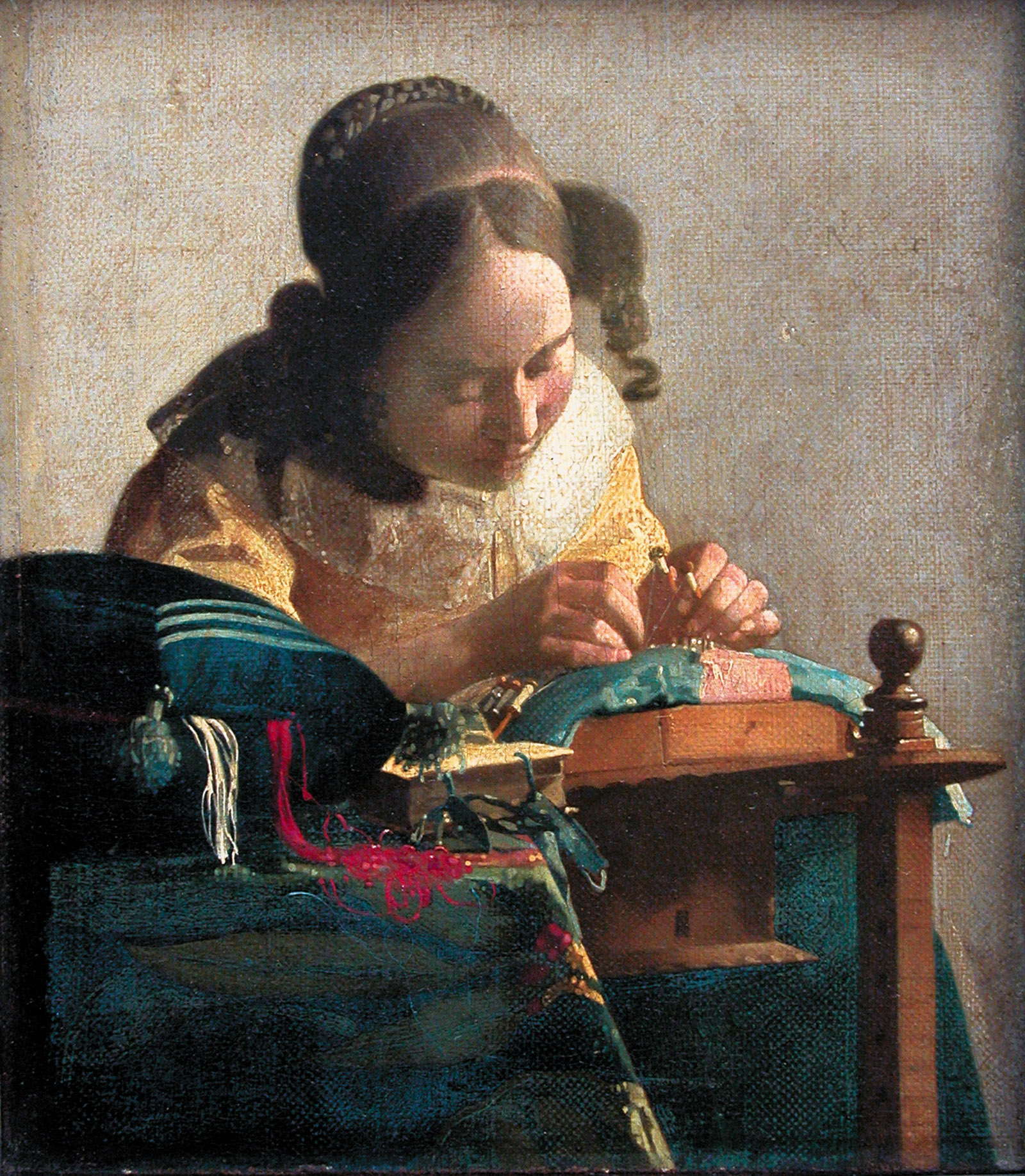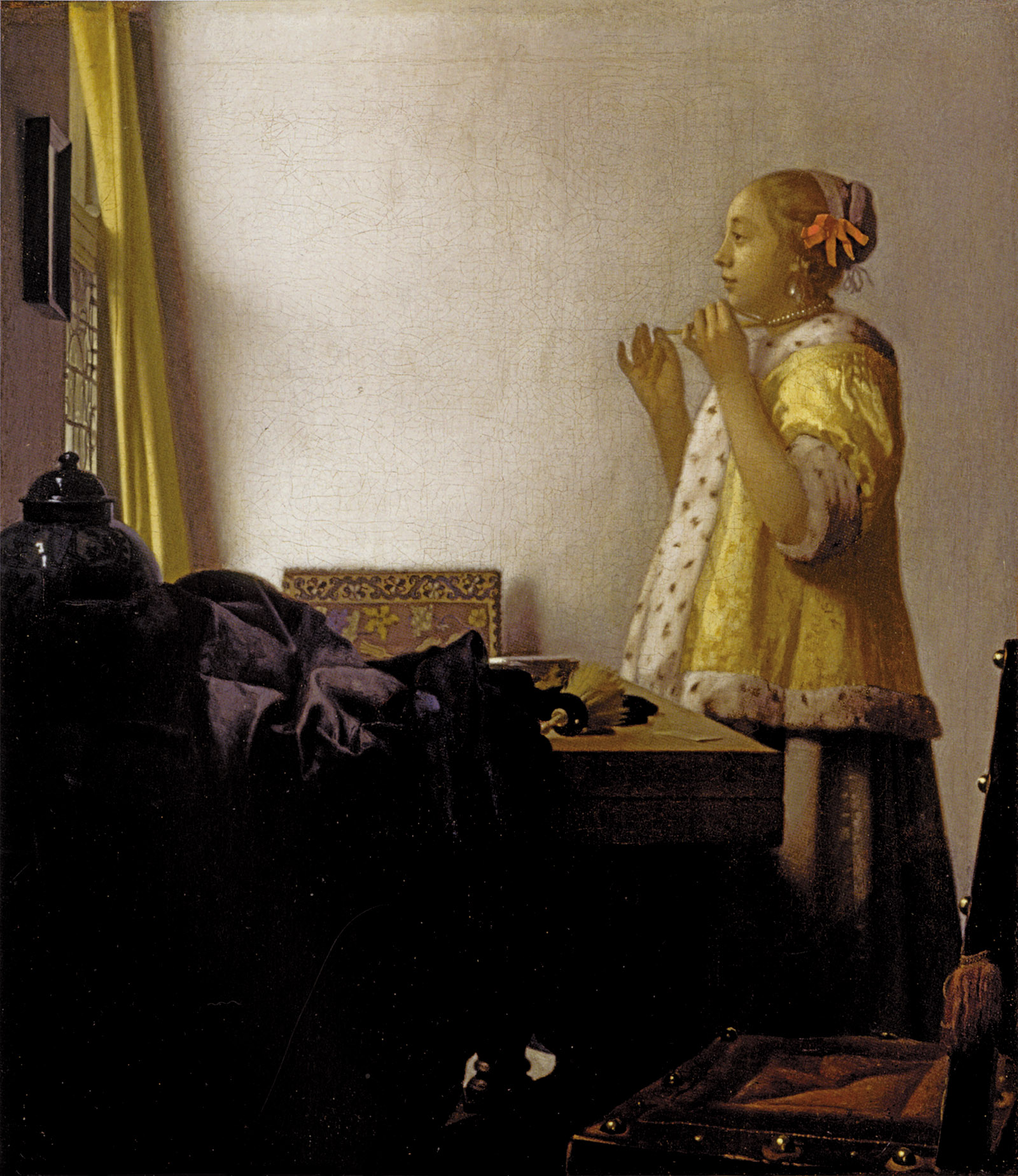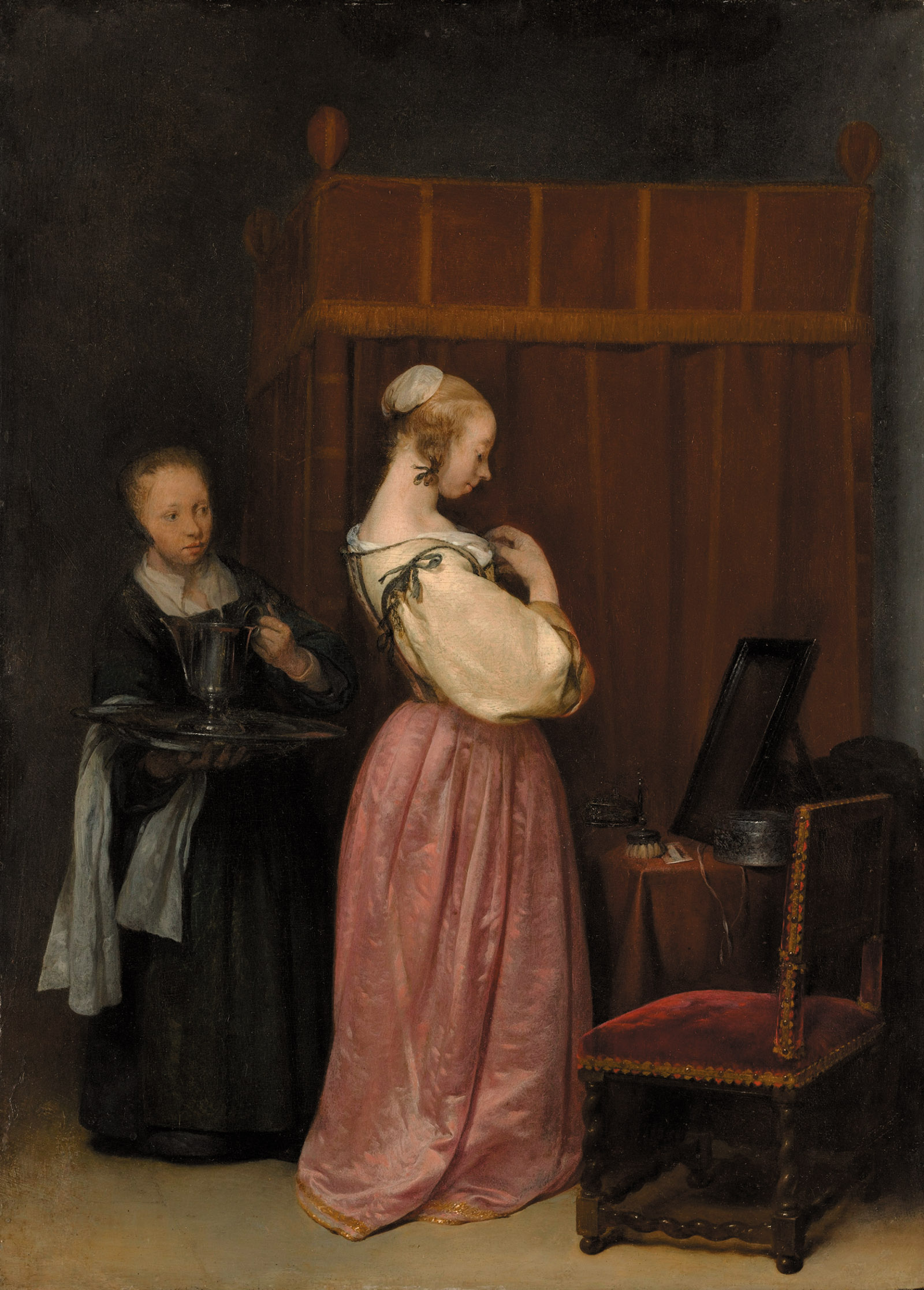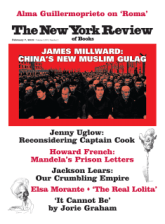On a May morning in 1921 Marcel Proust ventured from his bed, where he spent most of his time, to see an exhibition of Dutch painters at the Jeu de Paume. Organized to demonstrate the modern sensibilities of certain old masters, it had been lavishly praised, including by his friend Jean-Louis Vaudoyer, who reviewed it under the title “The Mysterious Vermeer.” Vermeer had been an obsession for Proust since he saw The View of Delft at The Hague in 1902 and called it “the most beautiful painting in the world.” In Swann’s Way (1913), Vermeer figured prominently as the epitome of aesthetic perfection and an impediment to human relations. The novel finds Charles Swann stalled in his attempt to write on the painter. Although this project continues to derail his courtship efforts, “in reality” Swann had “abandoned [them] years ago.”
Proust had hoped to write a study of Vermeer himself. Through Swann he expressed the fear that his own masterpiece would remain unfinished—at his death in 1922 the last three volumes of À la recherche du temps perdu were still in draft. So famous were Proust’s reflections on Vermeer that the 1921 exhibition included The View of Delft just so the ailing novelist could behold his favorite painting one last time. As if addressing Proust, Vaudoyer described that canvas in an overtly Proustian way, as déjà vu: “You see again this stretch of rose-gold sand…. You see again this immense sky.”
A photograph survives of Proust’s excursion. The last taken of the writer before he died, it shows him standing erect and elegant outside the Jeu de Paume. Before leaving his bed he confided that he didn’t want to ruin the exhibition by dying in the galleries. These worries found fictional expression. The character Bergotte—a writer and another of Proust’s alter egos in the novel—dies in front of a Vermeer. Lured from his sickbed by the words of a critic, Bergotte seeks in the canvas (which “he adored and imagined that he knew by heart”) a detail he had missed or forgotten: an exquisitely painted patch of wall. He wanders galleries hung with paintings that all seem “artificial” and arrives at the Vermeer, a work “more different from anything else that he knew.” His head spinning, he finds the yellow patch—and finds his life wanting: “My last books are too dry, I ought to have gone over them with several coats of paint, made my language exquisite in itself, like this little patch of yellow wall.” Repeating to himself “little patch of yellow wall,” he expires.
It is Vermeer’s most dramatic reception. But the epiphany of the painter’s difference from others in the tradition, and the intuition that this uniqueness is mysteriously founded in paint per se, “exquisite in itself,” have been common themes in the Vermeer literature since his modern rediscovery. In 1866 the French art critic Théophile Thoré, writing under the pseudonym Wilhelm Bürger, claimed to have rescued the artist from oblivion. He called Vermeer “the Sphinx of Delft” due to the silence of past historians and the enigmatic quality of his art. On Thoré-Bürger’s initiative, the 1866 Paris Salon included a loan show containing eleven paintings attributed to “Jan van de Meer.” Critics swooned. Representative of everyone “disinherited” by history, Vermeer, in a reviewer’s words, “evokes no parallels or comparisons.”
Compared to other Dutch masters whose biographies and oeuvres were established, Vermeer was unknown. Deemed the result of his having been ignored in his day (archives showed he died bankrupt), this oblivion became proof of his modernity. “We go to him,” wrote Gustav Vanzype in a 1908 monograph that Proust owned, “because a sort of mysterious prescience made him see as we see, made him discern, divine, and anticipate a sensibility that would not develop until two centuries after him.” This sensibility was one that allowed things to appear as they are, sometimes to the point of obscurity—in anticipation of Impressionism or (more uncannily) of photography.
Vaudoyer wrote that it was impossible to mistake a Vermeer for the work of another master, but the path to his recovery was riddled with error. Thoré-Bürger attributed seventy-four paintings to him, more than twice the number currently accepted. And he singled out for special acclaim works that turned out to be by an amateur, Dirk Jan van der Laan, active in Zwolle around 1800. A later generation corrected these errors, but the rage for Vermeers and their scarcity drove prices up, encouraging frauds and forgeries. A doyen of art historical scholarship, Abraham Bredius, who had unmasked Van der Laan’s imitations, was duped into declaring Han van Meegeren’s forgery The Supper at Emmaus “the masterpiece of Johannes Vermeer of Delft.” Van Meegeren’s confessions, made in 1947 while in the dock as Nazi collaborator, caused much soul-searching among connoisseurs. By the 1970s, the number of authentic Vermeers had dropped to thirty-one—the accepted oeuvre currently stands between thirty-four and thirty-seven works.
Advertisement
Meanwhile, historians unearthed a wealth of information about the painter’s domestic life, patrons, religion, and finances, and they debunked the myth of Vermeer as an unrecognized genius. He turns out to have been collected, admired, and imitated in his day. His eclipse was due to his limited output and narrow circle of patrons, and to accident: the chief early authority on Dutch art, Arnold Houbraken (1660–1719), listed other famous painters from Delft but accidentally missed out on Vermeer—he seems not to have turned the relevant page of his source, Dirck van Bleyswijck’s 1667 Description of the City of Delft, which names Vermeer as a new artistic “phoenix.”
And yet the idea of Vermeer’s obscurity remains. “It seems the greatness of Vermeer’s stature is almost equal to the dearth of knowledge about him,” writes Jane Jelley in her recent Traces of Vermeer, only then to build on the considerable body of established facts. Something about Vermeer continues to make him sphinxlike no matter how much we know. Vaudoyer explained that this is because the artist turned his back on us: “His face remains unknown to us, like his life, like his death.” He was referring to The Art of Painting, Vermeer’s pictorial manifesto, in which a painter—probably a self-portrait—faces away from the viewer as he paints a female model. For Vaudoyer, Vermeer faces away in order to turn us toward his work, all his work, and not just The Art of Painting. Who the painter really is, and who his model is, that woman in blue, posing but reserving something for herself: these are unknowable, in the painting as they would be in life. All we can know is that Vermeer saw these persons in this way.
The idea spoke to Proust, who insisted that an author’s true self is revealed only in his books, and whose novel dramatizes the gap between individuals. Artworks show their maker by manifesting the unique way the world appears to that one person. Without art this difference “would remain the secret of every individual.” Vermeer’s secret is that he unlocks everyone’s secret—in the all-encompassing but inexpressibly individual “how” of our perception of the world. “Thanks to art, instead of seeing one world, our own, we see it multiplied and as many original artists as there are, so many worlds are at our disposal,” wrote Proust, “whether their name be Rembrandt or Vermeer.”
For Proust and his contemporaries, Vermeer was fundamentally different, the artist who set his painted world most apart from all other worlds, including the art world of the Dutch Republic in its heyday. Proust complained that the Louvre hung Vermeer’s Lacemaker with other Dutch masters: the work should be exhibited “as a masterpiece, apart.” Many would still agree. Museums tend to display Vermeer among Dutch works of his period, but most visitors pass these by to get to the canvas they know and love, expecting from it alone a life-changing experience.
An extraordinary exhibition that closed last year posed a powerful challenge to this view. “Vermeer and the Masters of Genre Painting: Inspiration and Rivalry” gathered around a core of a dozen Vermeers some sixty canvases by other Dutch masters, reactivating them in a group conversation. The family resemblances proved striking. All painted on canvases of a modest scale, all in portrait format, these pictures feature wealthy ladies and gentlemen in elegant interiors. The actions depicted are all of an ordinary kind. People knit, write letters, drink wine, eat oysters, fuss with their clothing, and so forth—though the range is also constricted. The ordinary isn’t simply anything ordinarily done but finds expression in certain market-tested scenarios. The repetition of these encouraged cunning variation, improvement, or disruption, inviting viewers to recognize what was good in each painting.
Also shared among the paintings are the artifacts featured in them. Brass chandeliers, marble tiled floors, gilt leather walls, and precious glassware, silver, and ceramics attest to the affluence of the artists’ clients, many of whom prospered in the luxury trade. The paintings are aspirational. As Marjorie Wieseman writes in the excellent catalog of the exhibition, even the wealthiest Dutch homes could not boast the huge marble chimneypieces shown in the background of several paintings. The repertoire of valuables allowed painters to distinguish themselves as well. The ubiquitous Turkish rugs allowed craft know-how and individual manner to shine. In their essay, Melanie Gifford and Lisha Deming Glinsman detail the distinctive ways artists captured these attention-grabbing textiles—Vermeer worked quickly, wet-in-wet, while Gerrit Dou built his carpets knot by knot. Certain effects became signature specialties. Gerard ter Borch came up with an inimitable way of painting satin that amazed patrons and challenged rivals.
Advertisement
Vaudoyer wrote that Vermeer had “no relatives,” yet here his DNA has been sequenced, and the matches are astonishing. Adriaan Waiboer opens his account with a textbook instance of a pictorial lineage. Starting with Vermeer’s Woman with a Pearl Necklace (circa 1662–1665), he describes how most people imagine it was made. From his studio, the artist glimpses his wife, Catharina, dressing. Just as she pulls her necklace tight around her neck, Vermeer cries, “Hold that pose!” While it may seem a caricature, this is how many writers, from Proust to Tracy Chevalier (whose 1999 novel, Girl with a Pearl Earring, was a best seller), imagine the artist at work, finding his motifs spontaneously and capturing them from life.
Waiboer shatters this fantasy. He introduces Frans van Mieris’s Woman Before a Mirror (circa 1662), a painting of the sort Bergotte passed over on his way to Vermeer, but it matches Vermeer’s canvas so closely that the resemblance cannot be accidental. “There is little doubt,” Waiboer concludes, “that Van Mieris’s picture, rather than Catharina’s morning toilet, inspired Vermeer to paint Woman with a Pearl Necklace.”
Seeing Van Mieris’s picture in a collector’s home or dealer’s shop, Vermeer might have recognized that it had been inspired by an earlier work by Ter Borch, Young Woman at Her Toilet with a Maid (circa 1650–1651). Van Mieris embellished his precursor’s composition by introducing the motif of an opened letter, which suggests stories about love, disappointment, and vanity. Jan Steen—the comic of the group—had already added a love note to the mix. Riffing on the same Ter Borch, he painted Young Woman with a Letter (“Bathsheba with King David’s Letter”) (1659–1660). The canvas would pass for a domestic scene but for the phrase “most beautiful Bathsheba—because…” legible on the letter.
Vermeer thus joined a lively competition among rivals, each turning his prototype to his advantage—Van Meiris adding erotic innuendo, Steen evoking biblical history. Vermeer in turn blocked our access to the woman through a dark barrier of table and chair. He left out the attendant maid, bathed the scene in wondrous light that the woman’s satin jacket turns to gold, and gave her a look of momentary but sublime self-awareness. He made it seem like it is the woman herself who stands apart, from him and us as amazed voyeurs. But viewed as artistic rivalry, this apartness becomes an effect engineered by Vermeer to set himself apart. As Eric Jan Sluijter demonstrates in his catalog essay “Emulative Imitation Among High-Life Genre Painters,” the goal was a “dissimilar similarity” that could foreground individual skill to an audience of connoisseurs.
A website designed in conjunction with the catalog records over a thousand distinct connections between the genre paintings of the leaders in the field in the years 1650–1675. It is a powerful demonstration—Vermeer first among equals, responding more to artworks than to the world—and the stakes are high. Two centuries before Thoré-Bürger, Dutch painting exemplified the idea that art reflects the time when it was made. All art was believed to do this—a Gothic cathedral reflected the worldview of the Middle Ages; Michelangelo embodied the Renaissance. This made art a window onto the past.
But in the Dutch case, the match between the paintings and their period was more extreme. For the first time artists depicted not some story from an ancient past but contemporary life around them. Such realism reflected specific historical conditions—hard-won freedom from foreign rule, the Protestant ethic, the hegemony of an urban middle class—and it did so with a unique directness. The Dutch already pictured their world—vividly—as nineteenth-century “historicism” would assert all human worlds to be: not a divine order (as in, say, Jan van Eyck) or a satanic disorder (as in Hieronymus Bosch) but the construct of a specific, time-bound social collective. At the core of their achievement stood the “merry companies,” paintings of people eating, drinking, and music-making—what Hegel called “the Sunday of life which equalizes everything and removes all evil.”
That Sunday passed, and over the next two hundred years art severed itself from communal life. It became “modern” less by reflecting modern circumstances than by miming earlier styles and turning inward. Vermeer’s rediscovery went hand in hand with a sense not only of his difference from his contemporaries, but also of his kinship with modern painters who try to capture life in the fugitive present moment. Placing him back among “the masters of genre painting” runs counter to this stubborn view. Such a view cannot be undone by historical argument alone. No one doubts that Vermeer was of his time. The question is whether his modernity, which has dazzled viewers for more than a century, can and should be denied.
“Genre painting” is too wide a term for what these painters mastered. Pictures of everyday life had been a Netherlandish specialty since the sixteenth century, though this new art form had not acquired a name. Coined in the eighteenth century, “genre” denoted the representation of types, of nameless people doing everyday things, as opposed to the identifiable individuals in portraits and history paintings. Almost all the early genre paintings looked down on their subjects. Bruegel’s festive peasants were comical figures laughed at in the villas of patricians; Teniers’s lowlife scenes furnished humorous entertainment for well-heeled burghers in their orderly homes.
Around 1650 a genre of genre painting arose that looked not down but across at its subjects. The portrait format of these canvases—earlier genre scenes were oriented horizontally—reflected this elevation, as did its focus on relatively few figures, compared to the crowded “merry companies” of old. Most important was the social milieu of these “high-life” genre paintings. Elegant ladies and gentlemen in lavishly appointed homes engage in the pastimes of a leisured class.
Two words from the period described these paintings. They were “bourgeois” (burgerlyk), as opposed to common or noble (in this they prefigure later art forms, most notably the novel). And they were “modern”: the paintings depicted contemporary life. This modern, bourgeois art had a brief run. It began around 1650, after the Peace of Westphalia secured Dutch independence, and it waned after 1672, when the republic was attacked by five great powers, never quite to recover economically. During this period hundreds of painters’ shops produced many hundreds of thousands of paintings for the widest public that painting ever enjoyed. But within this market “the masters of genre painting” formed an elite, their membership marked and sealed by their imitation of and rivalry with fellow members.
Waiboer, Wheelock, and their coauthors allow readers to play this game on their own. Works are discussed and illustrated in clusters, each featuring a shared motif or device, such as letter-writing, musical duets, mirrors, or pets. Certain chains of influence remain speculative, but the authors do not force them on the reader, and the general fact of influence is as fascinating as it is indisputable. It is common wisdom that people become poets by reading poetry and that artists work with schemata that represent reality by force of convention. Ernst Robert Curtius argued that all of European literature developed from an ancient seedbed of clichéd phrases called topoi—e.g., the “world turned upside-down” or “all must die.” Dutch high-life genre paintings derive from stock motifs as well, such as kitchen scenes and allegories of the four elements, the virtues and vices, and the five senses.
But there are new and unprecedented departures, too, and if one had to name the most valuable artist among these high-genre painters it would be Gerard ter Borch. Vermeer’s Woman with a Pearl Necklace derived, via Van Mieris, from Ter Borch, as we have seen. But in creating the original Young Woman at Her Toilet, Ter Borch might indeed have seen his model in real life and cried to her, “Hold that pose!” For she was the artist’s remarkable half-sister Gesina, who not only sat for many of his works, but who may have sparked her brother’s interest in private inner life in the first place. Already in the late 1640s, while Gerard was still painting portraits and lowlife scenes, Gesina began to turn her fascination with the vexations of love into illustrated poems. These she collected in an album preserved in the Ter Borch family archives, now in the Rijksmuseum.
Gesina’s verses reflect a period taste for Petrarch. But performed theatrically by Gesina for her painter brother, the expressions of expectation, worry, and disappointment that dominate love poetry gave Ter Borch, and through him all the other Dutch painters, new ways of visualizing subjective life. This is art about art—Gerard paints Gesina enacting Petrarchan love—but in life as in art, love follows old formulas as well. “The strange thing with all these love stories,” wrote the nineteenth-century Viennese humorist Johann Nestroy, “is that they always revolve around the same thing, but how they start and end is so endlessly different that watching them never gets boring.”
Among the stars of the exhibition were two pairs of paintings featuring an exchange of letters. Again, the idea originates with Ter Borch. Around 1658 he painted, in one canvas, an officer putting feelings into words while a courier awaits the dispatch, while in its pendant—to be hung to the right—the officer’s beloved seals her written response before handing it off to her maid. Partly a reflection of an emergent culture of epistolary exchange between ordinary people, partly a clever way of opening up the world isolated within the confines of a framed canvas, these companion pictures enlist the real space between them, allowing it to measure the reach of love’s yearning. More famous than the Ter Borchs is a pair of pendant paintings by Gabriël Metsu from the mid-1660s. Instances of the dual impact of Ter Borch and Vermeer, these canvases, now in Dublin, have (in the left picture) the man writing the letter and (in the right picture) the woman reading it. In the latter, a maid casually draws aside a curtain from a grisaille “painting in the painting” showing a ship in high seas.
Although split between two canvases and haunted (the grisaille reminds us) by the hazards of love, the story seems to unfold in a continuous world. This is because of a consistency of style. In both paintings space and light are rendered in Metsu’s trademark way. Style connects these pendants, but it also distinguishes them from their neighbors. Ter Borch’s pendants embrace a coherent but different world. Brought together for the first time in history, displayed at last as the companion pictures they originally were, their separate worlds communicate like loves or rivals. Vermeer left us no pendant canvases of corresponding lovers—only his Astronomer and Geographer of 1668 and 1669 were made to hang side by side. He opted to condense epistolary exchange into a single tableau, with an attendant maid evoking the world traversed.
In À la recherche du temps perdu, the narrator says of his beloved Vermeers, “they are fragments of an identical world.” Again, this is because they all belong to the artist’s specific vision. Maurice Merleau-Ponty wrote similarly that in Vermeer “all the moments of the picture, like one hundred needles on one hundred compass dials, indicate precisely the same immutable deviation.” The question is, Have the “dissimilar similarities” brought to light by Vermeer and the Masters of Genre Painting moved the compass needle?
To my eyes the exhibition and its catalog have only intensified the deviation. We see more clearly that Vermeer set himself apart and we see how. Most obviously, he does so by setting his subjects apart from us. The other masters appeal to us theatrically by comparison. Dou’s framing curtains and parapets turn the pictorial field into a stage filled to the brim with dramatic narrative. Though candid by comparison, Ter Borch’s paintings address us too as voyeurs, with Gesina marvelously committed to her roles. Stories do unfold in Vermeer’s canvases. A woman listens as she tunes her lute, another pauses to think while writing a letter. But they do not seem to do so for us. The chairs, curtains, and tabletops that press toward us from Vermeer’s foregrounds contribute to this sense of turning inward and away.
But there’s more to Vermeer’s detachment than mere motifs. In the exhibition, his Lacemaker hung alongside three paintings of women doing needlework. With the exception of Dou’s, all capture their subject in an absorptive state, with the woman so engrossed in her task that she wouldn’t notice our presence were we really to stand before her. Positioning the lacemaker so that we cannot see what she is sewing, Vermeer prompts us to look at his handiwork. In the foreground, white and red paint—conjuring threads escaping from the woman’s sewing cushion—appears as if dribbled on the canvas. Many writers have drawn attention to Vermeer’s habit of blurring objects he represents. Where others seek to delineate, he allows painted forms to dissolve into the surface of the pigments they physically are—Bergotte’s fatal “yellow patch of wall.” This refusal of likeness and story makes writing about him a special challenge—Swann’s unwritten book.






